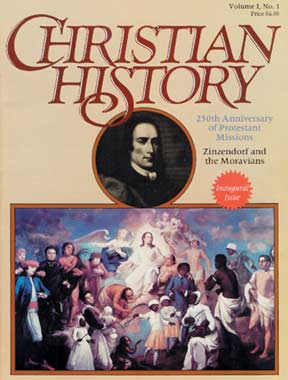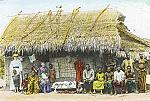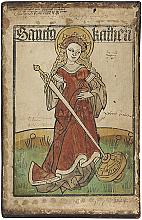The history of Christian History
[The first issue of Christian History.]
Christian History magazine started from unlikely roots. As a young man in the 1960s and 1970s, New Englander A. Kenneth (Ken) Curtis (1939–2011) trained in ministry and mass media at Gordon-Conwell Theological Seminary and Boston University Graduate School. This preparation led Ken into student ministry at a large Boston church and work in radio and TV.
In time Ken’s twin enthusiasms for film and faith led him to join a partnership that created the film The Cross and the Switchblade, which eventually led to the formation of Gateway Films. Gateway tried out various films in the Christian market, not finding much success until the company put one out on protoreformer Jan (or John) Hus. Ken related being “surprised and appalled” to discover how little people in evangelical Protestant churches knew about the faith’s historical heritage.
With John Hus, Gateway had found its niche. The company went on to coproduce the award-winning Shadowlands—the story of C. S. Lewis’s late-life love affair with Helen Joy Davidman—and many other quality films with historical themes. Ken’s films eventually garnered more than 30 awards, including an international Emmy. In 1981, during the explosive early years of the video industry, Ken founded a distribution company called Vision Video to make edifying, spiritually themed videos widely available. The company now carries over one thousand titles.
When the team began providing guidebooks with their historical films, starting with a 16-pager for the Hus production, they hit upon the formula for Christian History. The following year, as the young company developed a film on the eighteenth-century nobleman Nicolaus Von Zinzendorf and his far-reaching Moravian missionary movement, the guide concept became a full-blown magazine—and Christian History was born in 1982 with issue #1.
Ken jumped into the new magazine with the creative energy of a true entrepreneur. Remembers his son, Executive Editor Bill Curtis, “Dad would have these ideas in the morning—by the afternoon he’d write it up and off it went.”
After the issue on the Moravians came treatments of John Wesley and the Methodists, John Wycliffe, Huldrych Zwingli, the Anabaptists, and more. The magazine quickly settled into a quarterly schedule.
Transitions, on earth and in glory
By 1989 Christian History had grown to such proportions that it was becoming unwieldy for Ken’s small, Pennsylvania-based staff. He decided to transfer it to a company specializing in Christian magazine publishing: Christianity Today International (CTI). Though Ken remained involved in some aspects of CH, CTI took the reins for three decades.
When in 2002, as I (Chris) was finishing a PhD in church history at Duke University, I learned that the Christian History managing editor position was opening up—and then when I was chosen to fill it—I was as excited as I have ever been. In my travels I have met so many people who have been profoundly impacted by this magazine. I remember visiting a Mennonite archives in Lancaster County while working on our Anabaptists in America issue. There they prominently displayed Christian History, and an aging and bonneted archivist shared warmly about her love for it.
During my time as editor, I got to meet Ken and Bill and tour the red barn 30 miles outside of Philadelphia where Christian History was born. Ken struck me as a person of tremendous energy and vision with a pastor’s heart. I told him how, because he had followed his vision where it led him, he had changed my life. Discovering the magazine and seeing that our faith heritage could be communicated through a combination of vibrant storytelling and scholarly integrity led me to study church history academically. And I think a lot of readers are drawn into the magazine by that same combination of narrative power and historical accuracy.
Ken then shared with me the challenge he faced. In December 2002, he had been diagnosed with lung cancer and given less than two years to live. Most doctors he spoke with believed six months was a more reasonable estimate. Miraculously, however, as late as spring 2010, he was still living in what he called “bonus time,” even as his medical situation continued to mystify his doctors.
Meanwhile, as Ken considered how to best use his limited time, Christian History was facing its own limits. In 2008 the financial crisis hit, leaving CTI with some difficult decisions. CTI halted the print edition of CH at issue #99, along with half of its other magazines. Ultimately in 2010 CTI dropped the print edition, but an arrangement was made to transfer the magazine back to Christian History Institute.
In December of that same year, Ken’s doctors recommended he discontinue treatment and enter hospice care.
Ken’s dying dream was to publish issue #100 to recognize the 400th anniversary of the printing of the King James Bible.
After Ken’s passing on January 2, 2011, his son, Bill, picked up the torch. In spring 2011, through the efforts of the team in Pennsylvania working with me (Chris) and some new, talented editorial and art specialists across the country, Christian History was reborn with the long-delayed issue #100.
The issue went out with a letter explaining that the magazine was restarting under its original management and asking readers to consider providing feedback and a donation for future issues. What came next shocked and delighted us: an incredible outpouring of support in the form of prayers, gifts, and encouraging, enthusiastic letters. Such unprecedented support enabled issue #101: Healthcare and Hospitals to go to press later that year. It was no accident this topic was picked as we all thought about Ken’s eight-year journey with traditional and integrated medicine.
Two issues and the history of worship mini-guide were printed in 2012, and the year after that, the magazine began printing on a quarterly basis. Since then CH has published 49 more issues, continuing with the quarterly schedule that also included special and bonus issues, two additional guides, and two devotionals—all without a traditional subscription model but entirely through donor support.
Why Christian history?
Ken and the Christian History team wanted to address a sore lack in modern American Christianity. “Christians are handicapped by a lack of knowledge of the story of those who have preceded us in generations past,” he wrote in a “publisher’s note” in CH’s first issue. “An awareness of Christian history is one of the most neglected but necessary ingredients in the spiritual diet of Christians today.”
In other words Ken believed we need to read Christian history because the modern American church has cut itself off from the power and nourishment of its spiritual heritage (for more on “Why Christian history?” see p. 45). From the beginning, Christian History has tried to fill this lack, ministering this power and shared heritage to an amnesiac church, through stories told with integrity and care and filled with memorable details.
It has never been hard to find these stories—they are as many and as diverse as the global church. Categories of our issue topics reveal the values expressed in that very first publisher’s note. Always anchored in evangelical Protestantism with its care for the gospel and scriptural orthodoxy, CH has explored Paul and his times, how we got our Bible, the Bible teaching of various church fathers, heresy in the early church, the Council of Nicaea, the King James Bible, the Bible in America, and modern Protestant retrievals of ancient faith and practice.
With evangelicalism’s care for the missionary impulse and the global church, the magazine has also tracked the spread of the gospel through the centuries, giving our readers windows into the conversion and faith of whole people groups, from the Roman Empire in which the faith was born, outward to the early medieval Irish and Vikings, and beyond to Latin American, east Indian, African American, African (especially the twentieth-century church explosion on that continent), and Chinese Christian movements.
Since CH takes the gospel’s spread as often involving what Jonathan Edwards once called “the surprising work of God,” we’ve also attended to movements of renewal, faithfulness, and church growth that emerged early and often in the church, including monastic movements, Pietism, Puritanism, various American revivals, and “the camp meetings and circuit riders” that sparked expansive growth in Baptist, Methodist, Stone-Campbell, and other American evangelical church bodies.
The magazine published special issues on those remarkable leaders whose teachings and lives propelled the church forward as well: John Chrysostom, Augustine, Bernard of Clairvaux, Francis of Assisi, Thomas Aquinas, Martin Luther, Thomas Cranmer, Phoebe Palmer, and Dietrich Bonhoeffer, to name just a few.
We have also told the hard stories—about times of conflict and upheaval that have sometimes brought out the worst, and often the best, in those who have followed Christ—as well as frank and honest accounts of controversies and missteps. Among those conflagrations treated in our pages have been the American Revolution, the Civil War, the Industrial Revolution, Christianity and Judaism, and World Wars I and II.
Overall, CH has sought to uncover the story of the church around the world and in the places we don’t always look. While we love to tell the well-known and well-loved stories, we have also often uncovered episodes many readers have never heard of—stories that may surprise, inspire, and challenge us to think more deeply about our faith.
A mission and a ministry
We have always seen Christian History as a ministry to the church. Alert to both the good intentions and the flawed execution of fallen humans, and attending carefully to historical integrity, our scholar-authors have explored “the rest of the story”—unearthing vivid and sometimes surprising accounts of lives that were given to passionate service to God and neighbor, events and enterprises that changed lives, and movements that shaped and reshaped the world. With colorful details and dramatic twists, Christian History’s articles and features have shown us Christians trying to live faithfully here on earth even as they have anticipated the Lord’s return.
As Dr. Ken Curtis said in his first publisher’s note,
Understanding of Christian history will help us in many ways. We will uncover precedents in the past of how God has worked. We will gain perspective that will help us see our current situation in a new light. We will develop a sense of continuity and see how the unfolding of God’s purposes transcends any single generation, century, denomination, geography, or ideology.
We hope you have learned and grown in some of these ways through Christian History over the years, and we look forward to continuing to bring you edifying accounts from our shared heritage for many more years to come. CH
By Chris A. Armstrong and Bill Curtis
[Christian History originally published this article in Christian History Issue #150 in 2024]
Chris R. Armstrong is senior editor of CH and has been associated with the magazine since 2002. William K. (Bill) Curtis is executive editor of CH and has been associated with it since its founding.Next articles
Missions and martyrs
Some episodes from the early church
Edwin Yamauchi, William G. Bixler, J. Warren SmithThe emperor, the healer, and the teacher
Constantine, Basil, Augustine
David F. Wright, Timothy S. Miller, Dan GravesSupport us
Christian History Institute (CHI) is a non-profit Pennsylvania corporation founded in 1982. Your donations support the continuation of this ministry
Donate








